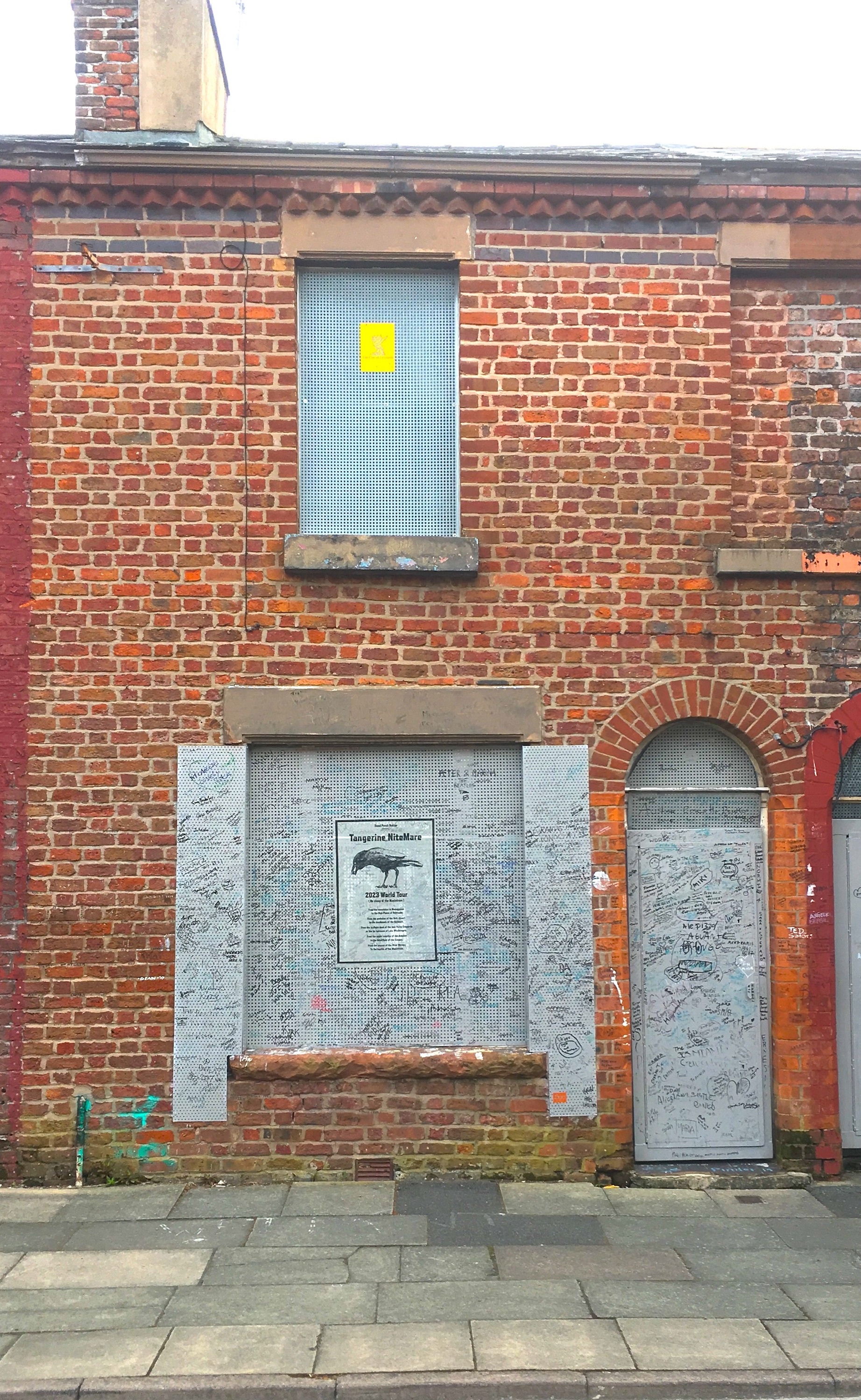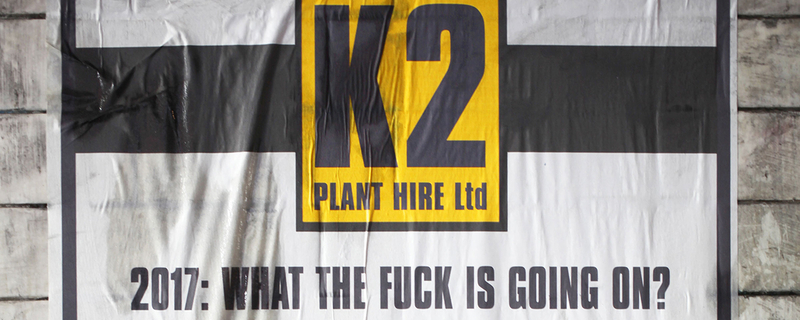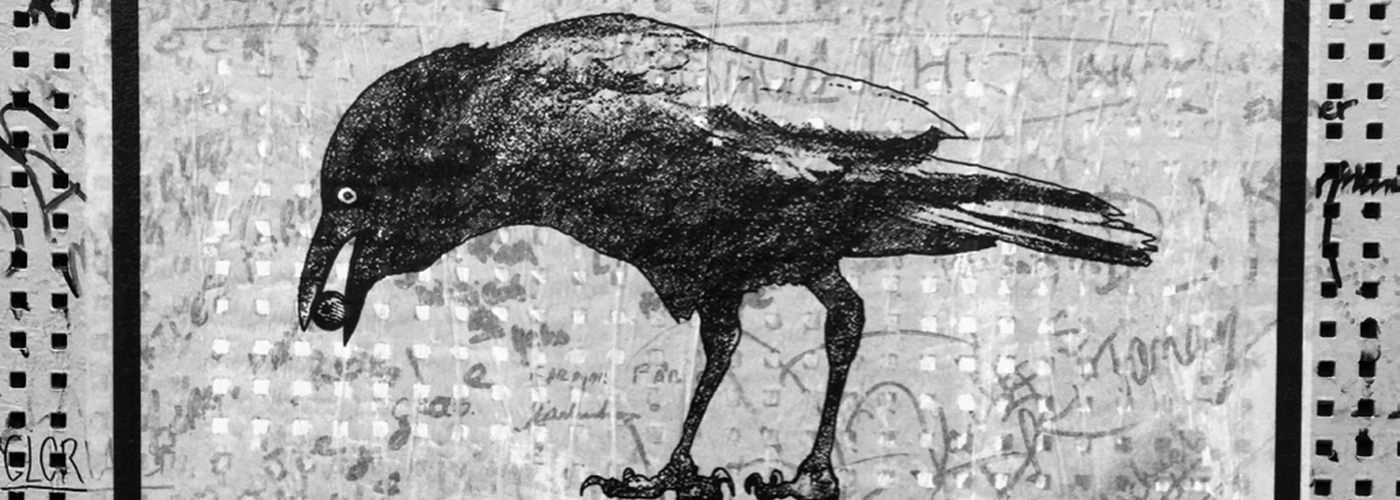There's even Liverpool KLF airport, with its pithy slogan, 'All Bound For Mu Mu Land'
PART ONE
DOES Liverpool really need another work of art about the KLF?
That's the question I'm asking myself, as I stand in front of Lime Street Station, on this impossibly blue skied day, in the spiritual home of the most famous band in the world.
Of course, you don't need me to tell you the story. There's probably no one alive on Earth who doesn't know the basics.
The prelude: two young lads, Bill and Jimmy, lynch-pins of the 1980s Liverpool scene. Hanging around at Eric's, managing bands, becoming the JAMs, making northern hip-hop, stealing stolen samples. Then the story itself. Turning into the KLF: the stadium house, the screaming crowds, the drugs, the robes, the American Tour. The Manual, the Timelords, the hysteria, the hype. Then the breakdown, the Brits, the machine guns, the Turner Prize, and the big pay-off, the show-stopper, the special effects budget: burning one million pounds. The greatest pop story ever told.
You know this. Everyone knows. The music of the KLF isn't something you like or dislike. It's just part of life. Played on the car stereo on family holidays. Whistled by the postman every morning. It's like Christmas, or Sunday lunch, or the moon. It's just there. It just is.
Here you can see tribute bands knock out their hits every Saturday: the Raspberry JAMs, the OK-LF
And, though they were only met here, didn’t even record anything here, and left for London once the going got good, this city has claimed Bill and Jimmy as its own. Liverpool offers you KLF taxi tours, and KLF Experiences. It has statues, and gift shops, and shopping centres named in Bill and Jimmy's honour. It has Justified and Ancient Ice Cream vans. There's even Liverpool KLF airport with its pithy slogan, 'All Bound For Mu Mu Land', and a pencil drawing of Bill Drummond's face as part of the logo. But I'm not here to see any of this. I've been summoned to see something new, one more piece of art about the band.
I've been promised something revolutionary, something more than another bronze statue, or a massive Timelords car on a roundabout. The instructions were very specific.
All journalists must pay their own train fare, it said. No expenses. Tickets will be checked. I liked their style. The press release also demanded that I walk a certain way through the city, down Mathew Street. It's probably to build up the tension. I start walking.
Liverpool is bright today. Blue skies. Green trees. Orange skin. I walk through the busy city centre, packed with people, past enormous shops and gigantic coffee bars, belting out autotuned, pumped up pop hits. I ignore them. Keep my head down. I find myself on the map. Lord Street. North John Street. I turn right onto Mathew Street, as instructed. And immediately I leave this busy city behind.
The first thing I see is Bill Drummond. At least, I think it's him. The likeness is OK, though his head is too big. It's in his leather trenchcoat era, the image worn on the T-shirts of a thousand Japanese school girls. There's no information on the artist, or what the statue's made of. Parts of it are peeling away. The head looks like it might be newer: maybe the old one was cut off, an art-terrorist attack, and is now a trophy on someone's bookshelf.
As I'm looking, people come over and stand next to him, pose for photos. A large woman, with a face that runs straight into her chest, holds her pink handbag tight and gives the thumbs up. A child pokes its fingers in Bill's mouth. Polish tourists with big guts and smart shoes throw their arms around his shoulders, and look off into the distance for a photo. There are no Liverpudlians here. Bill stands next to where Eric's used to be. Over the road is where the club is now, reconstructed, rebuilt. WHERE IT ALL BEGAN, as it says on the door, and beneath it, ERIC'S NOW WELCOMES FAMILIES UNTIL 7PM.
I follow the tourists down the stairs. The place is pretty busy. It's one part museum, one part depressing daytime bar. Disco lighting illuminates forlorn looking couples on KLF tours, having a pint where The KLF never sat. Here you can see tribute bands knock out their hits every Saturday: the Raspberry JAMs, the OK-LF. For some reason, the stereo plays Motown hits.
On the other side of the bar, they're selling some merchandise. It's all displayed in a big glass cabinet. Shot glasses, fridge magnets, KLF branded drum sticks, Jimmy and Bill earrings. An American buys six t-shirts, three white, three blue. There's Bill and Jimmy's faces again, massive brass reliefs, hung on the wall. The whole thing seems to be half fond, well-meant and half knock-off, almost cynical. At least you don't have to pay to get down here.
Back onto the street. To the right is Eric's Esplanades, a boutique shopping centre loosely themed on Bill and Jimmy. I don't go in. There are more sculptures, tacky benches, more themed KLF bars, all that shit. But what you realise most is what there isn't. Above these bars, there's nothing. The proud buildings are rotting, disused. The gutters are long nicked. The delicate windows bang open. At the far end, there are tacky bars boiling down every decade of popular music into soundtracks for office drinks. The street has recently been repaved, to help the piss drain better. I turn to go. It's getting to me. This street is nasty. Dead. A fake.
On the way out, I walk past the 3AM Hotel. I didn't notice it on the way in. There are statues of Bill and Jimmy on each corner. They both look like Noddy Holder.
Why do people come to see this? To stand next to this bad art, and buy all this shameless tat? To prove how much of a fan they are? To walk the same streets, even though those streets are long since repaved, demolished, tarted up? Do they like what they find? Is it value for money?
PART TWO
I WALK down to the bus station, as instructed. Down through the sheer, granite cliffs of the new uber-shopping centre in the middle of the city. The bus is the number 80, stand 7. I ask the driver for High Park Street. I'm heading towards the last piece in the KLF tour. The furthest flung piece of memorabilia: the house where Bill Drummond lived.
Who is leading me here? I'm not quite sure. They're a shadowy organisation, a kind of KLF-Liberation Front. Sometimes they call themselves The Justified Youth of Liverpool. Sometimes the KLF-LF. Their manifesto doesn't really make sense, but I'm not sure it's supposed to. '
"The KLF are not a merchandising opportunity'," it reads. "They are not a natural resource to be exploited, like coal. We want to take their music, their art and their ideas back from the hawkers and the theme pub owners. We want to reclaim the KLF for the people of Liverpool. For the people of planet Earth."
So far, that's involved a few art-terrorism stunts, in the spirit of the KLF themselves. They've stopped clocks at 3, all across the city, to make them read 3AM, eternally. They've boarded the last train to Manchester every night (23.26 in case you're interested), and, with the aid of some battery powered speakers, turned a whole carriage into the Last Train To Trancentral. All very clever-clever, but probably of no interest to the casual KLF tourist.
It's either A Terrible Waste Of Money, or one of the most powerful statements you could make
I get off the bus where High Park Street meets Princes Road, L8. I walk up High Park Street, past row after row of terraced houses, boarded up, waiting to be demolished. This is the master plan for Liverpool. Knock down decent houses, and build some massive shops. The terraces feel eerie, like a witness to the end of the world. No kids running around, no cats, no wheelie bins, no cars. No people. There's nothing left.
On one of these streets, Bill Drummond lived as an art student for two years. Madryn Street, number 9. From the outside there's nothing to give it away. No graffiti, no blue plaque. Despite this, the tourists come.

A taxi rolls past. It slows down, kerb-crawls past this piece of history. Slow enough that the fans inside can take pictures of whichever terrace they think is the right one. But not so slow that they can get out. And all the while, it turns out, the boarded-up door is open, to whoever has the nerve to push it.
The instructions tell me to push. Inside it smells damp. The dust gets up your nose. I close the door as instructed. There's no carpet on the stairs, but they seem steady enough. I climb up. I wish I'd brought someone else along. My mind starts racing. There's enough light in here through holes in the roof, but the silence is terrifying. I disturb a pigeon at the top of the stairs. My heart is throwing blood around my body. I can hear tinny voices. There's a white room ahead. I walk into the room. And suddenly everything makes sense.
In 1994, Bill and Jimmy withdrew the remaining £1 million from their KLF bank account. All the money they had left from being the pop stars they set out to mock. They chartered a plane and took it in suitcases up to the Scottish island of Jura. They found an abandoned cottage on a beach, and burnt the 50 pound notes in the fireplace, in neat bundles of 20 grand. They didn't even know why they did it, couldn't give a simple explanation. It was something to do with power, with showing that money isn't as important as being a human being, alive today.
Depending on your position, it's either A Terrible Waste Of Money, or one of the most powerful statements you could make.
The room in front of me is peaceful. It's painted white. The title is “What A Waste”. There are no names attached. The artists have recreated the burning of a million pounds. They've projected a fire into the fireplace, images of £50 notes, the flicker of flames. It's the film the KLF made of the event, the one you can find on the internet.
The soundtrack comes out of a tape recorder. You can hear the two of them talk, but mostly you can hear the crackle of the fire. It's peaceful, and lulling. It's simple. It's quiet. You can't put it on a mug or on a t-shirt.
I stay watching for what feels like an hour. The pigeons shift around me. No one else comes in.
I forget about the danger of being somewhere you're not supposed to be.
Does Liverpool need this, then? Yes. This is strong stuff. It's independent. It isn't on a roundabout. It isn't just an add-on, a piece of happy street furniture, to brighten up the shopping experience. It's got something to say, a little bit of bite. It tells you about the doubt, the questions the KLF asked, the stuff you can't reduce to a merchandising opportunity. They haven't asked permission to be in here. Haven't got funding.
The door is only open for one morning every week. Maybe by the time you get here the door will be locked. Maybe this house, this perfectly sound structure, will have been demolished.
But at the same time, it probably doesn't make much difference. Whatever these kids think, the KLF are still going to be the biggest band in the world. People are still going to come on the tours, because they want to. Japanese tourists will go on posing next to bad statues. Fat American tourists will still squeeze themselves into recreation Justified and Ancient Ice Cream Vans, to tour city streets that look nothing like the ones the KLF walked. Poseable Drummonds will still fly off the shelves. Because the music of the KLF is already universal, already belongs to everyone. It's just what Bill and Jimmy would have wanted.
I walk down the stairs, back out onto the dead streets. I retrace my steps, catch the bus, and whistle Tammy Wynette's vocals on Justified and Ancient. The KLF are in good hands.















